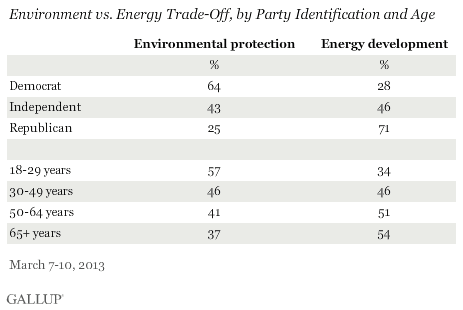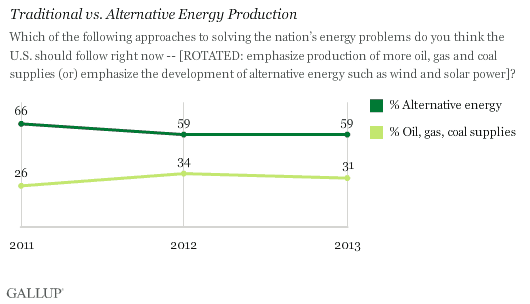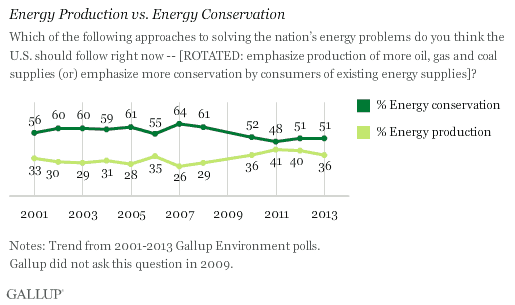PRINCETON, NJ -- Americans divide evenly when asked whether the U.S. should prioritize energy production (46%) or environmental protection (45%) when the goals conflict. From 2001 to 2008, Americans consistently came down on the side of the environment. Since 2009, they have been divided or shown a slight preference for energy production -- aside from a temporary shift back toward the environment in the wake of the April 2010 Gulf of Mexico oil spill.

Gallup has asked this question each March as part of its annual Environment survey, including March 7-10 this year. The trend generally mirrors what Gallup has found when asking about protecting the environment versus promoting economic growth. Both trends showed movement away from the pro-environment stance when the economy went into recession a few years ago, and the environment has yet to regain the majority position even as the economy has improved.
Although Americans overall are divided in the environment vs. energy trade-off, certain subgroups -- most notably party and age-based ones -- have decided preferences on which should prevail. Democrats want the environment to have a higher priority by a 64% to 28% margin, while Republicans favor energy production by an even larger margin -- 71% to 25%.
Younger Americans are most likely to want to give preference to environmental protection, but each older age group shows a successively greater preference for energy production, with Americans older than age 50 coming down on the side of energy.

Gallup has typically found younger adults and Democrats more in favor of environmental protection than Republicans and older adults. Since the early 2000s, Democrats' and younger adults' views have changed little, while Republicans and older adults have shifted more toward a pro-energy stance. Independents have also moved more in the direction of energy production in recent years.
Americans Favor More Environmentally Friendly Ways to Make Energy Available
Although Americans are divided on whether energy production or environmental protection should have the higher priority, they tend to favor more environmentally friendly ways to address the nation's energy problems.
Specifically, when asked whether the U.S. should emphasize production of more traditional energy supplies such as oil, coal, and gas or alternative energy sources such as wind and solar power, 59% favor alternative energy, while 31% prefer traditional energy. This roughly two-to-one preference for alternative energy production has been consistent in the three years Gallup has asked this question.

Americans' preference for alternative energy is also apparent when Gallup asks Americans how much the U.S. should emphasize each of six specific energy sources.
The public also has consistently favored energy conservation over energy production as a means of ensuring adequate U.S. energy supplies. This year, 51% say the U.S. should emphasize conservation and 36% production. This 15-percentage-point gap represents one of the smallest margins in favor of conservation Gallup has found since 2001. The smallest was a seven-point margin in 2011.

Implications
The potential conflicts between energy production and environmental protection have been apparent in recent energy policy debates such as the Obama administration's decision to reject a proposal to build the Keystone XL pipeline between Canada and the U.S. Additionally, the U.S. and several state governments are considering the pros and cons of "fracking" procedures to extract oil and natural gas buried deep below the ground in locations around the U.S.
Americans are currently divided as to whether energy development or environmental protection should win out, which is a shift from a decade ago when Americans more consistently came down on the side of the environment. Even so, Americans remain sensitive to the environmental impact of energy production, seeing alternative energy and energy conservation as better approaches to addressing the nation's energy problems than producing greater supplies of traditional energy like oil, coal, and gas.
Survey Methods
Results for this Gallup poll are based on telephone interviews conducted March 7-10, 2013, with a random sample of 1,022 adults, aged 18 and older, living in all 50 U.S. states and the District of Columbia.
For results based on the total sample of national adults, one can say with 95% confidence that the margin of sampling error is ±4 percentage points.
Interviews are conducted with respondents on landline telephones and cellular phones, with interviews conducted in Spanish for respondents who are primarily Spanish-speaking. Each sample of national adults includes a minimum quota of 50% cellphone respondents and 50% landline respondents, with additional minimum quotas by region. Landline telephone numbers are chosen at random among listed telephone numbers. Cellphone numbers are selected using random digit dial methods. Landline respondents are chosen at random within each household on the basis of which member had the most recent birthday.
Samples are weighted to correct for unequal selection probability, nonresponse, and double coverage of landline and cell users in the two sampling frames. They are also weighted to match the national demographics of gender, age, race, Hispanic ethnicity, education, region, population density, and phone status (cellphone only/landline only/both, cellphone mostly, and having an unlisted landline number). Demographic weighting targets are based on the March 2012 Current Population Survey figures for the aged 18 and older U.S. population. Phone status targets are based on the July-December 2011 National Health Interview Survey. Population density targets are based on the 2010 census. All reported margins of sampling error include the computed design effects for weighting.
In addition to sampling error, question wording and practical difficulties in conducting surveys can introduce error or bias into the findings of public opinion polls.
View methodology, full question results, and trend data.
For more details on Gallup's polling methodology, visit www.gallup.com.
